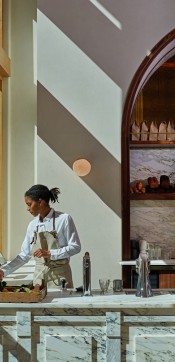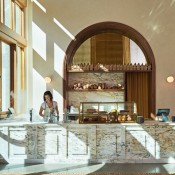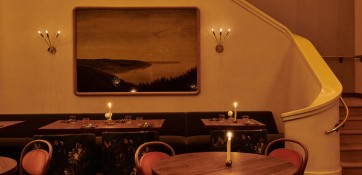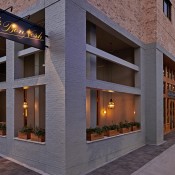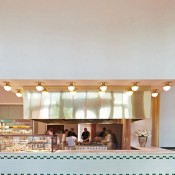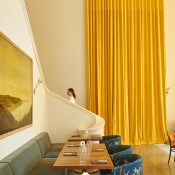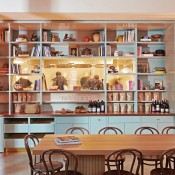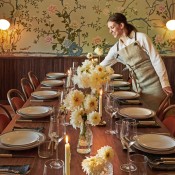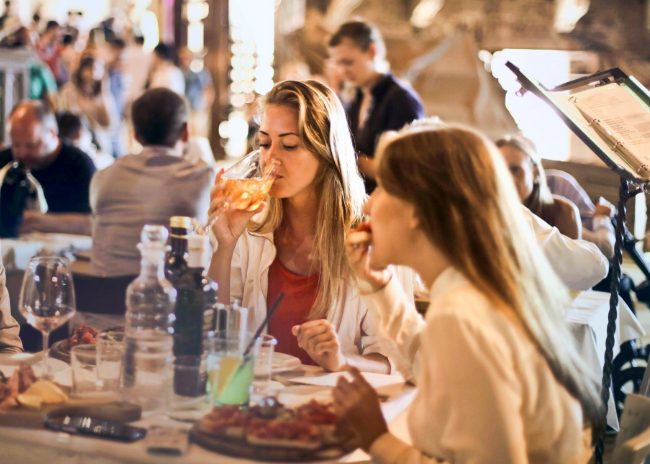Opened last November on the ground floor of The Irby, a 12-story, 275-unit residential development in the heart of Atlanta’s upscale Buckhead neighborhood, Le Bon Nosh is a study in both design and flexible space utilization.
Inspired by Paris’ café culture, the operation brings to life owner and executive chef Forough Vakili’s vision for a casual-yet-sophisticated all-day café, market, wine bar and restaurant celebrating the simplicity of high-quality, seasonal local ingredients and warm hospitality.
Designed by Los-Angeles-based studio Commune and two years in the making, the 6,300-squre-foot, two-level space includes an open display kitchen with custom range and wood grill as its centerpiece. The kitchen is flanked by a market with oak communal tables on one side and a more formal dining room and wine bar on the other. The market area also includes a barista station, bakery, grab-and-go food cases and display of kitchen essentials. From the dining room, an elegant staircase leads up to a hidden mezzanine that serves as a 40-seat private dining and event space.
“Food literally and symbolically anchors the space,” according to Commune principal Roman Alonso. “But the concept of community and gathering informed the layout, as well.”
For Vakili, every aspect of Le Bon Nosh’s design and ambiance is personal and intentional, a reflection of her journey toward creating her own “community-minded” food destination. The child of Iranian immigrants, she came to the U.S. as an adolescent and studied chemical engineering at Georgia Tech before switching career goals to pursue her passion for food and cooking. She attended Le Cordon Bleu in Paris and worked in a two-Michelin-star restaurant in Brittany before returning to Atlanta, where she served as culinary consultant for Porsche Cars North America and Bon Appetit Management Company while planning of Le Bon Nosh.
Design and culinary influences inspired by both her Iranian roots and her time in France interplay throughout the operation. Inside the Art Deco-inspired cypress façade, layered, handwoven rugs add color and texture. Naturally dyed cotton velvet drapes divide the double-height space and infuse drama. Tones of saffron and pomegranate, chosen for the drapes and seating upholstery, respectively, recall for Vakili childhood years spent on her family’s farm in Iran. Pale blue and teal plaster reference colors of the French coast and are represented more literally in a commissioned feature painting beneath the curved staircase. For the private dining area upstairs, the designers enlisted a French design house to create hand-painted scenic garden wallpaper featuring florals and pomegranate trees on a blue silk background.
The restaurant’s various spaces had to be flexible and easily accessible throughout the day, but also provide a more elevated, intimate experience for evening occasions. “Forough pointed us towards the casual elegance found in Parisian and Viennese cafes and we filled the spaces with pieces made famous by these storied establishments,” notes Alonso. Such pieces and materials include classic bentwood chairs, custom tables inspired by minimalist French designer Jean-Michel Frank, vintage Viennese chandeliers and sconces, Persian rugs, botanical textures, warm walnut and brass accents, white marble and artisan ceramic tiles. The result, he adds is, “A truly personal space — a restaurant that is home to a uniquely multi-national life.”
Images courtesy of Anthony Tahlier
